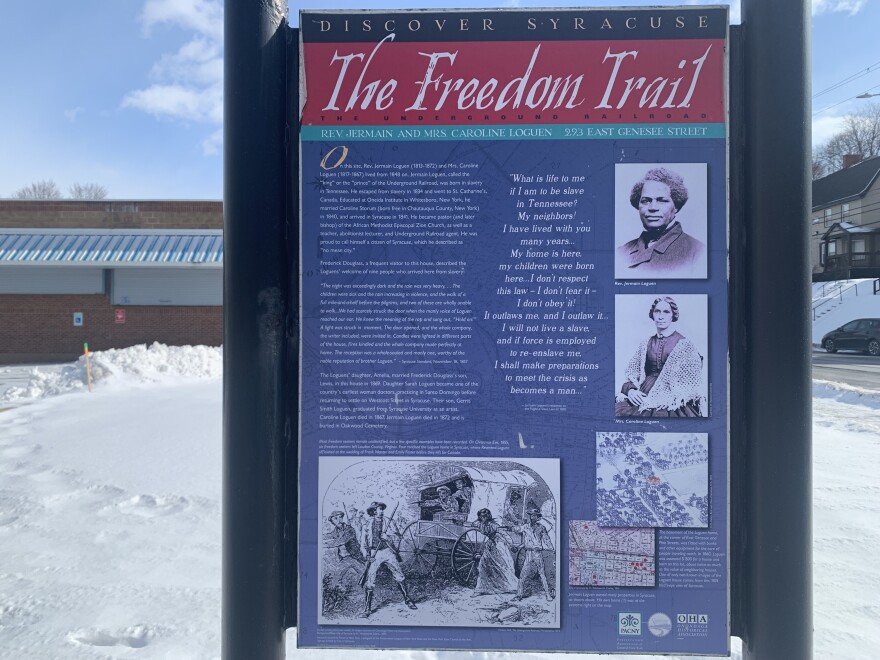February is Black History Month. In our latest look at local African American history, we learn about the luminaries who took the Declaration of Independence by its words, that “all men are created equal.” Although it passed in 1776, it took nearly another decade for abolitionists to help 1,500 people escape slavery, many of them along the Freedom Trail through Central New York.
The City of Syracuse played a central role to aid freedom seekers along the Underground Railroad. The Freedom Trail is marked by signage at key historic sites such as where Jermain and Caroline Loguen’s home once stood at 293 East Genesee Street, bordering Pine Street. A historic marker contains a portion of one of Jermain’s most powerful speeches. He delivered it at Syracuse City Hall in August of 1850 to speak-out against America’s Fugitive Slave Law.
“’I don’t respect this law, I don’t fear it, I don’t obey it, it outlaws me; and I outlaw it....”
Robert Searing read aloud from the historical speech...
“’...I will not live a slave and if force is employed to re-enslave me, I shall make preparations to meet the crisis as becomes a man.’ And later in the speech he ends and he says, ‘We must crush this tyranny by force or be crushed by it.’”
Searing is reading it from a roadside marker noting where Loguen once lived. It is now a closed pharmacy that is about to be demolished and built into housing units. Searing is the Onondaga Historical Association Curator. He deeply respects Loguen and his wife and how they welcomed African Americans into their home as a key stop on their quest for freedom. Searing explains while Harriet Tubman from Auburn is largely credited for the Underground Railroad; Jermain Loguen was revered as the Underground Railroad King to his abolitionist contemporaries.

“With his wife Caroline who is kind of an unsung hero in all of this, just a few feet from where we are standing, a few blocks from the Erie Canal, will shepherd upwards of 1,500 enslaved peoples to freedom. All while organizing, buying property, taking care of, helping with Samuel May running the Fugitive Slave Aid Society here in Syracuse.”
Less than a year after Loguen delivered his speech, Searing said he helped carry out the “Jerry Rescue” for William Henry in October of 1851. Longtime Syracuse University Professor Emeritus of African American history Milton Sernett recalls a lesser known abolitionist, Lucy Watson. The black teenage girl born into freedom, poured whiskey on Henry’s wounds and helped remove his restraints.
“She and others tried to get off his leg irons with a hammer and a flat iron… and she buries them in the backyard. The shackles that bound his wrists were more difficult to get off. And so they called upon a member, Peter Lilly a nearby blacksmith - who was an abolitionist - who filed them off.”
At the time, Syracuse citizens were far more progressive than much of the country. Many assisting in the “Jerry Rescue,” were affluent citizens like Doctor Hiram Hoyt who came to the escapees’ medical aid, and Reverend Samuel May – a white man – who preached equality for all.
“Syracuse had a Vigilance Committee, a bi-racial committee of abolitionists who would go into action if there was a potential capture," he said.
Reverend May came to - what is now known as May Memorial Unitarian Universalist Society – in 1845. Mary Louise Edwards is with the church’s History Committee. She said May’s reputation for welcoming everyone at a prior church preceded him.
“One of the things he got in trouble about in Connecticut was letting a black family… he wanted to move down in front so that they could see better. Because they were a big family and crowded in the back and some of his parishioners did not like the fact that he was having this black family move forward and sit in the front of the church.”
Edwards said May did not have the support of his wealthy Boston roots. While his father was compassionate, he did not have the courage to outwardly finance May’s efforts. However, the son never forgot the compassion a black woman showed him when she gave him medical aid after he had fallen as a young man.
“She disappeared before he actually got to thank her. From an early age he had good experiences with African Americans, with Jewish people. So, he didn’t seem to have any prejudices.”
When the Underground Railroad ended in 1861, Edwards says May stayed active with his church until his death a full decade later in 1871.
Perhaps the most prolific abolitionist is Frederick Douglass who found freedom in Central New York. His ability to argue the U.S. Constitution’s intent in claiming that all men are created equal gave lawmakers the courage to ultimately progress themselves.



